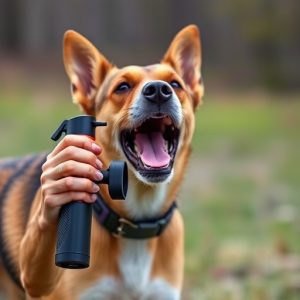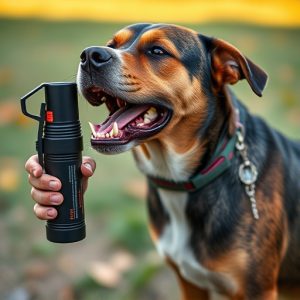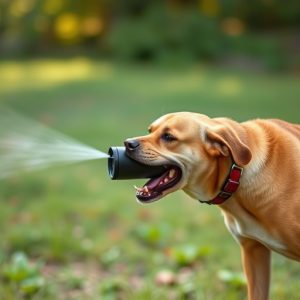Mastering Dog Aggression: Safe Pepper Spray Training Techniques
Dog aggression, driven by fear or past trauma, requires careful management. Proper Mace Spray Dog Tr…….
Dog aggression, driven by fear or past trauma, requires careful management. Proper Mace Spray Dog Training Techniques teach owners and handlers safe use of pepper spray as a last resort, focusing on body language cues, application technique, and environmental control. Using "dog training sprays" with controlled capsaicin levels ensures effectiveness without harm. Clear commands, strategic aiming, and consistent practice build trust. Post-training support includes positive reinforcement and clear household guidelines for safe co-existence with a trained dog.
“Learn how proper Mace spray dog training techniques can revolutionize your safety. This comprehensive guide delves into understanding dog aggression, selecting the ideal pepper spray for training, and mastering application methods. From choosing the right gear to post-training support, we explore every aspect of safe and effective mace spray usage. Ensure your well-being and foster a positive bond with your canine companion by implementing these expert tips for successful dog training.”
- Understanding Dog Aggression and Pepper Spray Safety
- Choosing the Right Pepper Spray for Dog Training
- Effective Mace Spray Application Techniques
- Post-Training Support and Safety Measures
Understanding Dog Aggression and Pepper Spray Safety
Dog aggression can stem from a variety of factors, including fear, territorial instincts, or past trauma. Recognizing the signs of impending aggression—such as growling, snarling, or elevated fur—is crucial for both dog owners and passersby. Understanding these cues allows for quicker responses, which can help defuse potentially dangerous situations. Proper Mace Spray Dog Training Techniques focus on teaching both dogs and their handlers how to recognize and manage these behaviors effectively.
Using pepper spray as a deterrent during dog attacks is only one part of a comprehensive safety strategy. It’s essential to note that pepper spray should be used as a last resort, when all other de-escalation methods have failed. Proper training involves learning safe application techniques, understanding the range and effectiveness of pepper spray, and knowing how to administer it without causing harm to the dog or bystanders. This includes recognizing the dog’s body language and environmental factors that might affect the spray’s impact, ensuring both safety and efficacy during an attack.
Choosing the Right Pepper Spray for Dog Training
When considering pepper spray as a tool for dog training, it’s crucial to select the right product designed specifically for canine behavior modification. Not all pepper sprays are created equal; those meant for personal defense may not have the desired effect on dogs due to their unique physiology. Look for products labeled as “dog training spray” or “canine deterrant,” which are formulated with a safer, less potent capsaicin concentration suitable for training scenarios without causing severe harm or long-lasting effects on your pet.
Proper use of mace spray for dog training involves mastering the technique to ensure effectiveness and minimize stress on the animal. This includes understanding the appropriate distance, duration of application, and post-spray care. Training sessions should be conducted in a controlled environment, preferably with the help of a professional trainer, to teach dogs an alternative response to unwanted behaviors without resorting to physical harm.
Effective Mace Spray Application Techniques
When training dogs to respond properly to mace spray, it’s crucial to employ the right application techniques. Start by ensuring clear communication; use verbal commands like “Stop” or “Back away” consistently before spraying. This helps the dog associate the command with the action, making it more effective in real-world scenarios.
For proper application, hold the canister upright, aiming slightly below the dog’s face. Spraying directly into the face can cause discomfort and may not stop a determined attack. Instead, target the eyes and nose, as the irritant can quickly distract and disorient the dog, giving you time to move away safely. Practice these techniques in controlled environments to build trust and ensure your dog responds appropriately under pressure.
Post-Training Support and Safety Measures
After teaching your dog proper behavior and ensuring they respond well to commands, it’s crucial to maintain a safe environment for everyone involved. Post-training support is essential to reinforce positive behaviors and prevent any potential incidents. One effective tool that can aid in this process is Proper Mace Spray Dog Training Techniques. This method involves the strategic use of pepper spray to deter aggressive behavior without causing harm.
When implementing these techniques, it’s vital to practice in a controlled setting, gradually increasing the intensity of stimuli. Regular, positive reinforcement training sessions will help your dog associate certain commands or actions with rewards, making them more receptive to guidance during potentially stressful situations. Additionally, keeping pepper spray readily available and ensuring all household members know its proper use can significantly enhance safety measures around your trained dog.
In conclusion, understanding dog aggression and employing proper mace spray techniques during training can significantly enhance safety. Choosing the right pepper spray and learning effective application methods are crucial steps in preventing attacks. Additionally, post-training support measures ensure that dogs remain well-behaved and safe for everyone involved. By adhering to these guidelines, you can effectively navigate dog aggression and foster positive interactions through responsible mace spray use.


